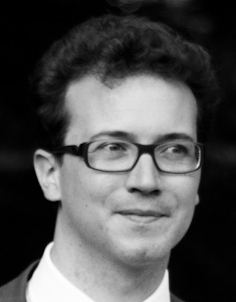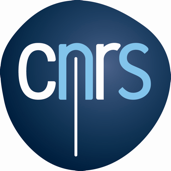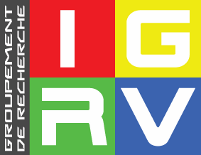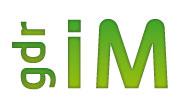Journée du GT GDMM
La journée du Groupe de Travail de Géométrie Discrète et Morphologie Mathématique des groupes de recherche IM et IGRV est l'occasion pour les enseignants-chercheurs, chercheurs, doctorants de se rencontrer, d'échanger sur les travaux les plus récents, d'initier de nouvelles collaborations sur tous les thèmes de la géométrie discrète et de la morphologie mathématique.
Quand ?
La journée du GT aura lieu le 20 juin 2018. Elle précède les JIG.
Où ?
Bâtiment Darwin D, Salle Fontanès,
Campus de l'Université Lyon1, La Doua,
23-25 Avenue Pierre de Coubertin,
69 622 Villeurbanne.
Orateurs invités
- Jean Cousty (ESIEE Paris, LIGM)
- Antoine Vacavant (UCA, Institut Pascal)
Inscriptions
L'inscription est gratuite. Il suffit d'indiquer sa participation à la journée du GT dans le formulaire d'inscription commun aux JIG : https://jig2018.sciencesconf.org/
Programme scientifique
- Orateur invité : Antoine Vacavant
- Milena/Pylene
- Présentations de doctorants (1/2)
- Orateur invité : Jean Cousty
- DGtal
- Discussions GT
- Présentations de doctorants (2/2)
Organisateurs
Tristan Roussillon
Comité Local : Raphaelle Chaine, David Coeurjolly, Guillaume Damiand, Julie Digne, Florent Dupont, Aldo Gonzalez Lorenzo, Vincent Nivoliers,
Contact: jig2018@liris.cnrs.fr
Journées précédentes
- les 3 et 4 mai 2017, XLIM-SIC Poitiers GT GDMM 2017
- le 14 juin 2016, LSIS Marseille GT geodis 2016
- le 26 novembre 2015, LIRIS Lyon GT geodis 2015
- le 25 novembre 2014, CReSTIC Reims GT geodis 2014
- le 13 juin 2013, LIGM/LIAFA Paris GT geodis 2013
- le 08 juin 2012, IRCCyN Nantes GT geodis 2012
Programme scientifique du mercredi 20 juin
| 9h30 | Accueil |
| 10h | Antoine Vacavant, orateur invité |
| 11h | Edwin Carlinet et Thierry Géraud, Bibliothèque en C++ moderne pour le traitement d'images générique et performant |
| 11h30 | Présentations de doctorants (1/2) :
|
| 12h30 | Repas |
| 14h00 | Jean Cousty, orateur invité |
| 15h00 | Nouveautés de DGtal |
| 15h15 | Discussions GT |
| 15h30 | Pause |
| 16h00 | Présentations de doctorants (2/2) :
|
| 17h30 | Fin |
Titres et résumés

Antoine Vacavant (UCA, Institut Pascal) |
Algorithmes robustes et multi-échelles de traitement d'images, impliquant des outils de géométrie discrète et de morphologie mathématique Abstract: Une problématique récurrente au traitement d’images est la présence d’une perturbation incontrôlée et destructrice dans l’image : le bruit. Dans la littérature, la faculté d’un algorithme à résister au bruit est généralement nommée robustesse, mais sans modélisation claire de celle-ci. Dans cette présentation, je donnerai en premier lieu une définition originale et fondatrice de la robustesse des traitements d’images, en considérant plusieurs échelles d’études du bruit. Puis, différentes contributions robustes et multi-échelles, faisant appel à des outils de la géométrie discrète et de la morphologie mathématiques, seront présentées. Cet exposé se poursuivra avec des méthodes combinant ces deux approches, pour adresser des problématiques d'analyse d'images médicales du foie. Il se terminera par la proposition d’axes de recherche novateurs sur la robustesse des algorithmes de traitement d’images, orientés vers des applications biomédicales. |

Jean Cousty (ESIEE Paris, LIGM) |
Watersheds and hierarchical analysis in graphs Abstract: Many image segmentation methods look for a partition of the set of image pixels such that each region of the partition corresponds to an object of interest in the image. Hierarchical segmentation methods, instead of providing a unique partition, produce a sequence of nested partitions at different scales, enabling to describe an object of interest as a grouping of several objects of interest that appear at lower scales. This methodology became very popular in recent years as attested by the number of citations reached by an article by Arbelaez et al on this subject: more than 2500 citations since its publication in 2011 ! The watershed transform is often considered for the finest level of details in a hierarchical segmentation. In the first part of this presentation, we present the watershed cuts, a notion of a watershed in an edge-weighted graph. Watershed cuts are defined following the intuitive idea of drops of water flowing on a topographic surface. We first establish the consistency of these watersheds: they can be equivalently defined by their "catchment basins"(through a steepest descent property) or by the "dividing lines" separating these catchment basins (through the drop of water principle). Then, we state, through an equivalence theorem, their optimality in terms of minimum spanning forests. In this framework, hierarchies of watershed cuts can be defined based on nested minimum spanning forests. In the second part of this presentation, we study three representations of hierarchies of partitions: dendrograms (direct representations), saliency maps, and minimum spanning trees. We provide a new bijection between saliency maps and hierarchies based on quasi-flat zones hierarchy as used in image processing and characterize saliency maps and minimum spanning trees as solutions to constrained minimization problems where the constraint is quasi-flat zones preservation. In practice, these results form a toolkit for proposing new hierarchical methods and algorithms where one can choose the most convenient representation. In particular, it allows us for proposing efficient hierarchical watershed cut algorithms and new methods for combining multiple hierarchical segmentations. These results also invite us to process non-image data with morphological hierarchies. |



